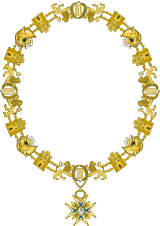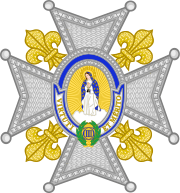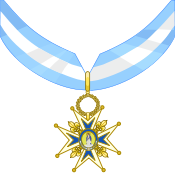You can help expand this article with text translated from the corresponding article in Spanish. (December 2009) Click for important translation instructions.
|
| Order of Charles III | |
|---|---|
 Star and sash of the Order Star and sash of the Order | |
| Awarded by the King of Spain | |
| Type | Order of merit, Knighthood |
| Established | 1771; 254 years ago (1771) |
| Royal house | House of Bourbon |
| Motto | VIRTUTI ET MERITO ("Virtue and Merit") |
| Awarded for | Actions in benefit to Spain and the Crown |
| Status | Currently Constituted |
| Sovereign | King Felipe VI |
| Grand Chancellor | Pedro Sánchez, Prime Minister |
| Grades | Knight/Dame of the Collar Knight/Dame Grand Cross Commander by Number Commander Knight's/Dame's Cross |
| Precedence | |
| Next (higher) | None |
| Next (lower) | Order of Isabella the Catholic (for diplomatic relations), Order of Civil Merit (for civic virtues). |
Sash & ribbon of a Collar grade member of the order Sash & ribbon of an ordinary member of the order | |

The Royal and Distinguished Spanish Order of Charles III, originally Royal and Much Distinguished Order of Charles III (Spanish: Real y Distinguida Orden Española de Carlos III, originally Spanish: Real y Muy Distinguida Orden de Carlos III; Abbr.: OC3) is a knighthood and one of the three preeminent orders of merit bestowed by the Kingdom of Spain, alongside the Order of Isabella the Catholic (established in 1815) and the Order of Civil Merit (established in 1926). It was established by the King of Spain Charles III by means of the Royal Decree of 19 September 1771, with the motto Virtuti et mérito. It rewards political appointees, heads of State and high-ranking government officials for their actions in benefit to Spain and the Crown.
History
Although the royal decree of creation was in September 1771, Charles III did not make the orders public that would regulate the distinction until 24 October. The reason for this lies in the origin of the Order. The future king and prince of Asturias, Charles IV, had been married for five years with no offspring, reason for which when his first child was born his grandfather, Charles III, wanted to leave evidence of his gratitude to God — to whom he declared having prayed to while waiting for the continuation of the dynasty — and, specifically, to the Virgin Mary in his advocacy of the Immaculate Conception and of whom he declared himself the profoundly devout king. Like so, on the given date, when the king's daughter-in-law assisted the first religious affair with the child in her arms, the king wanted to publish the laws of concession, naming himself "Great Master of the Order" and giving his heirs, as long as they held the title "King of Spain", the same treatment and position. Although the child and various brothers died soon after, Charles III maintained his agreement, and the number of Crosses given was greatly reduced at the monarch's regret.
The orders of creation demanded two requirements: to be "worthy and affectionate of His Highness". Two classes were created: the Knights Grand Cross and the Knights, also known as caballeros pensionados ("Pensioner Knights", or simply pensionados, "pensioners"), the monarch being discretional with his authorization, although it was limited to sixty of the former and two-hundred of the latter.
Pope Clement XIV, on 21 February 1772 recognized the Order through papal bull and bestowed upon it the religious benefits, to the Order as well as its members, giving the Great Master all the capacity to decree in religious matters regarding the members, even absolution and apostolic blessing. The benefits of the members of the Order were of a different nature, later increasing with Pius VI.
The insignias of the Order have varied throughout time, but have invariably maintained some original features: blue silk band with white design, an eight-point cross with the image of the Immaculate Conception, the motto Virtuti et Merito and the figure of Charles III.
In 1783 the third class of Supernumerary Knights was created. At this moment the duties and requirements of the titles were specified: they needed to have "pure and noble blood" up to their great-grandparents, as was regulated by the Castilian Fueros and the other valid laws. Those received by the Order took an oath for loyalty towards the king, his family, and the protection of the goods of the Royal House, recognizing him as Great Master, live and die in catholic faith, accepting as indisputable the Mystery of the Immaculate Conception, and attending and receiving communion at mass at least once a year.
The government of the Order became more and more complex, although in truth it was the monarch and the treasurer who granted authorization and retributions. The king was especially careful to incorporate into the Order theologians of the Crown that investigated the mysteries of the Virgin Mary, in some cases the clergymen being greater in number than the knights and nobles of which it was made up. The meetings were held in the Church of San Gil in Madrid twice a year, one coinciding with the Immaculate Conception and the other with the All Saints' Day. With Charles IV of Spain some reforms were made to the dress and the distribution of colours in the distinctions. The Peninsular War caused two institutions to attribute the faculty of the government of the Order: Joseph Bonaparte and the Suprime Central Junta. In the end, these were abolished by the Joseph. The colours of the band of the Order were adopted by some members of the Provisional Government of Argentina to signify their adhesion to King Ferdinand VII and would later come to represent the movement for independence.
In 1815, Ferdinand introduced a new star for the Pensioner Knights, showing the reverse of the badge.
The Order was formally converted to a civil order in 1847. The classes of Pensioner Knights and Supernumerary Knights were transformed into the classes of Commander by Number and Knight, respectively. The Knights Grand Cross and Commanders by Number were limited to 120 and 300 respectively, while the new class of Commanders and the Knights are unlimited until today. In 1878, the Knight of Collar was introduced as the highest class of the order, limited to 60 recipients.
The order's current regulations were approved by Royal Decree 1051 of 2002. The regulation sets the objective of the order as a means of "rewarding the citizens who, with their effort, initiative and work, have brought a distinguished and extraordinary service to the Nation". The Grand Master of the order is the monarch of Spain, currently King Felipe VI, and the Grand Chancellor is the prime minister, currently Pedro Sánchez.
The Grand Cross


The Grand Cross of the Order of Charles III is reserved for those who, having completed relevant service to Spain, having been Presidents of the Congress of Deputies, the Senate, the Constitutional Court of the Supreme Judicial Council, the Supreme Court, Ministers or other senior officials of the state. The maximum number of Grand Crosses are limited to one hundred, not counting those accorded to Ministers.
Knights/Dames of the Collar and Knights/Dames Grand Cross of the Order are entitled to be addressed with the honorific The Most Excellent in front of their name. Other members are entitled to the honorific of The Most Illustrious.
Grades
The orders are currently conferred in the following grades:
- Knight/Dame of the Collar (Collar) – restricted to 25 Spanish citizens (not including members of Spain's royal family).
- Knight/Dame Grand Cross (Gran-Cruz) – restricted to 100 Spanish citizens (limit excludes government ministers).
- Commander by Number (Encomienda de Número) - restricted to 200 Spanish citizens (limit excludes government ministers).
- Commander, optional Dame's Bow (Encomienda, Lazo de Dama opcional).
- Knight's Cross (Cruz).
Women appointed to an applicable grade are not called Knights (Caballeros). Women are instead appointed as Dames of the Collar (Damas del Collar), Dames Grand Cross (Damas Gran Cruz) or Dame's Cross (Cruz de Damas).
There are no restrictions on the number of foreigners that may be appointed to any of the grades.
Current members

Knights and Dames of the Collar
| # | Knight / Dame | Appointment | Notes |
|---|---|---|---|
| 1 | Juan Carlos I (b. 1938) |
1962 | King of Spain and Grand Master (1975–2014) |
| 2 | António Ramalho Eanes (b. 1935) |
1978 | President of Portugal (1976–1986) |
| 3 | Carl XVI Gustaf (b. 1946) |
1979 | King of Sweden (since 1973) |
| 4 | Margrethe II (b. 1940) |
1980 | Queen of Denmark (1972–2024) |
| 5 | Akihito (b. 1933) |
1981 | Emperor of Japan (1989–2019) |
| 6 | Sofia of Spain (b. 1938) |
1983 | Queen consort of Spain (1975–2014) |
| 7 | Vigdís Finnbogadóttir (b. 1930) |
1985 | President of Iceland (1980–1996) |
| 8 | Felipe VI (b. 1968) |
1986 | Current King of Spain and Grand Master (since 2014) |
| 9 | Henri (b. 1955) |
2001 | Grand Duke of Luxembourg (since 2000) |
| 10 | Mohammed VI (b. 1963) |
2005 | King of Morocco (since 1999) |
| 11 | Abdullah II (b. 1962) |
2006 | King of Jordan (since 1999) |
| 12 | Harald V (b. 1937) |
2006 | King of Norway (since 1991) |
| 13 | Nicolas Sarkozy (b. 1955) |
2009 | President of France and Co-Prince of Andorra (2007–2012) |
| 14 | Michelle Bachelet Jeria (b. 1951) |
2014 | President of Chile (2006–2010; 2014–2018) |
| 15 | Enrique Peña Nieto (b. 1966) |
2015 | President of Mexico (2012–2018) |
| 16 | Marcelo Rebelo de Sousa (b. 1948) |
2018 | President of Portugal (since 2016) |
| 17 | Leonor de Borbón (b. 2005) |
2023 | Princess of Asturias (since 2014) |
| 18 | António de Oliveira Guterres (b. 1949) |
2023 | Secretary-General of the United Nations (since 2017) |
| 19 | Willem-Alexander (b. 1967) |
2024 | King of the Netherlands (since 2013) |
| 20 | Sergio Mattarella (b. 1941) |
2024 | President of Italy (since 2015) |
See also
See also: Category:Orders of chivalry of SpainReferences
- "Real Orden de Carlos III". Casa Real de España (No Oficial) (in Spanish). 2016-09-19. Retrieved 2022-03-03.
- ^ (Spanish) Royal Decree 1051/2002, 11 October, by which the Regulation of the Royal and Distinguished Spanish Order of Carlos III is passed
- article 1, Reglamento de la Real y Distinguida Orden Española de Carlos III
- article 2, Reglamento de la Real y Distinguida Orden Española de Carlos III
- "Article 5(3)". Reglamento de la Real y Distinguida Orden Española de Carlos [Regulations of the Royal and Distinguished Spanish Order of Carlos III] (in Spanish).
- ^ "Article 7". Reglamento de la Real y Distinguida Orden Española de Carlos [Regulations of the Royal and Distinguished Spanish Order of Carlos III] (in Spanish).
- Satow, Ernest Mason, Sir. A Guide to Diplomatic Practice. p. 249 – via Archive.org.
{{cite book}}: CS1 maint: multiple names: authors list (link) - "Article 13". Reglamento de la Real y Distinguida Orden Española de Carlos III [Regulations of the Royal and Distinguished Spanish Order of Carlos III] (in Spanish).
Los miembros de la Orden tendrán los tratamientos siguientes:
[The members of the Order shall have the following titles:
a) Los Caballeros y las Damas del Collar, así como los Caballeros y Damas Gran Cruz, recibirán el tratamiento de excelentísimo señor y excelentísima señora.
b) Los demás miembros de la Orden tendrán el tratamiento de ilustrísimo señor e ilustrísima señora.
a) Knights and Dames of the Collar, as well as Knights and Dames Grand Cross, shall receive the title of His/Her Excellency.
b) Other members of the Order shall have the title of His/Her Most Illustrious.] - "Article 9(3)". Reglamento de la Real y Distinguida Orden Española de Carlos III [Regulations of the Royal and Distinguished Spanish Order of Carlos III] (in Spanish).
- "BOE-A-1962-11227 Decreto 1193/1962, de 10 de mayo, por el que se concede el Collar de la Real y Muy Distinguida Orden de Carlos III a Su Alteza Real el Príncipe don Juan Carlos de Borbón y Borbón". www.boe.es. Retrieved 2024-03-15.
- "BOE-A-1978-14493 Real Decreto 1242/1978, de 2 de mayo, por el que se concede el Collar de la Real y Muy Distinguida Orden de Carlos III al excelentísimo señor Antonio Ramalho Eanes, Presidente de la República de Portugal". www.boe.es. Retrieved 2024-03-15.
- "BOE-A-1979-26756 Real Decreto 2565/1979, de 15 de octubre, por el que se concede el Collar de la Real y Muy Distinguida Orden de Carlos III a Su Majestad Carlos XVI Gustavo, Rey de Suecia". www.boe.es. Retrieved 2024-03-15.
- "BOE-A-1980-8628 Real Decreto 738/1980, de 15 de marzo, por el que se concede el Collar de la Real y Muy Distinguida Orden de Carlos III a Su Majestad Margarita II, Reina de Dinamarca". www.boe.es. Retrieved 2024-03-15.
- "BOE-A-1981-14506 Real Decreto 3206/1980, de 23 de octubre, por el que se concede el Collar de la Real y Muy Distinguida Orden de Carlos III a Su Alteza Real el Príncipe Heredero Akihito". www.boe.es. Retrieved 2024-03-15.
- "BOE-A-1983-28595 Real Decreto 2747/1983, de 31 de octubre, por el que se concede la Banda del Collar de la Real y Muy Distinguida Orden de Carlos III a S. M. la Reina Doña Sofía". www.boe.es. Retrieved 2024-03-15.
- "BOE-A-1985-19477 Real Decreto 1635/1985, de 11 de septiembre, por el que se concede la Banda del Collar de la Real y Muy Distinguida Orden de Carlos III a Su Excelencía la Señora Vigdis Finnbogadottir, Presidenta de Islandia". www.boe.es. Retrieved 2024-03-15.
- "BOE-A-1986-2416 Real Decreto 117/1986, de 24 de enero, por el que se concede el Collar de la Real y Muy Distinguida Orden de Carlos III a su Alteza Real el Príncipe de Asturias, Don Felipe de Borbón y Grecia". www.boe.es. Retrieved 2024-03-15.
- "BOE-A-2001-9151 Real Decreto 525/2001, de 11 de mayo, por el que se concede el Collar de la Real y Muy Distinguida Orden de Carlos III a Su Alteza Real Enrique, Gran Duque de Luxemburgo". www.boe.es. Retrieved 2024-03-15.
- "BOE-A-2005-782 Real Decreto 20/2005, de 14 de enero, por el que se concede el Collar de la Real y Distinguida Orden Española de Carlos III a Su Majestad el Rey Mohamed VI de Marruecos". www.boe.es. Retrieved 2024-03-15.
- "BOE-A-2006-7241 Real Decreto 501/2006, de 21 de abril, por el que se concede el Collar de la Real y Distinguida Orden Española de Carlos III a su Majestad el Rey Abdulah II de Jordania". www.boe.es. Retrieved 2024-03-15.
- "BOE-A-2006-11883 Real Decreto 823/2006, de 30 de junio, por el que se concede el Collar de la Real y Muy Distinguida Orden de Carlos III a Su Majestad el Rey Harald V de Noruega". www.boe.es. Retrieved 2024-03-15.
- "BOE-A-2009-6944 Real Decreto 769/2009, de 24 de abril, por el que se concede el Collar de la Real y Distinguida Orden Española de Carlos III al Excelentísimo Sr. Nicolas Sarkozy, Presidente de la República Francesa". www.boe.es. Retrieved 2024-03-15.
- "BOE-A-2014-10888 Real Decreto 913/2014, de 24 de octubre, por el que se concede el Collar de la Real y Distinguida Orden Española de Carlos III a la Excelentísima Señora Michelle Bachelet Jeria". www.boe.es. Retrieved 2024-03-15.
- "BOE-A-2015-6859 Real Decreto 527/2015, de 19 de junio, por el que se concede el Collar de la Real y Distinguida Orden Española de Carlos III al Excelentísimo Señor Enrique Peña Nieto, Presidente de los Estados Unidos Mexicanos". www.boe.es. Retrieved 2024-03-15.
- "BOE-A-2018-5100 Real Decreto 223/2018, de 13 de abril, por el que se concede el Collar de la Real y Distinguida Orden Española de Carlos III al Excelentísimo señor Marcelo Rebelo de Sousa, Presidente de la República Portuguesa". www.boe.es. Retrieved 2024-03-15.
- "BOE-A-2023-21040 Real Decreto 783/2023, de 10 de octubre, por el que se concede el Collar de la Real y Distinguida Orden Española de Carlos III a Su Alteza Real la Princesa de Asturias, doña Leonor de Borbón y Ortiz". www.boe.es. Retrieved 2024-03-15.
- "BOE-A-2023-22792 Real Decreto 820/2023, de 8 de noviembre, por el que se concede el Collar de la Real y Distinguida Orden Española de Carlos III al excelentísimo señor António Manuel de Oliveira Guterres, Secretario General de las Naciones Unidas". www.boe.es. Retrieved 2024-03-15.
- "Real Decreto 349/2024, de 26 de marzo, por el que se concede el Collar de la Real y Distinguida Orden Española de Carlos III a Su Majestad el Rey Guillermo Alejandro de los Países Bajos." www.boe.es. Retrieved 2024-04-05.
External links
 Media related to Order of Charles III at Wikimedia Commons
Media related to Order of Charles III at Wikimedia Commons











